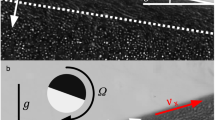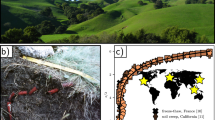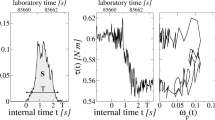A surprising resistance would be put up by sand grains hiding a buried treasure chest.
Abstract
Penetration by an object through a dense granular medium (for example, by a finger pushing slowly into the sand on a beach) presents an interesting physics problem1 that is closely related to issues of practical importance in soil science2,3. Here we measure the penetration-resistance force for an object approaching the solid bottom boundary of a granular sample — analogous to the finger approaching a flat rock buried in the beach. We find that the penetration resistance near the boundary increases exponentially, which demonstrates the existence of an intrinsic length scale to the ‘jamming’ caused by a locally applied stress.
This is a preview of subscription content, access via your institution
Access options
Subscribe to this journal
Receive 51 print issues and online access
$199.00 per year
only $3.90 per issue
Buy this article
- Purchase on Springer Link
- Instant access to full article PDF
Prices may be subject to local taxes which are calculated during checkout

Similar content being viewed by others
References
Albert, R., Pfeifer, M. A., Barabási, A.-L. & Schiffer, P. Phys. Rev. Lett. 82, 205–208 (1999).
Yu, H. S. & Mitchell, J. K. J. Geotech. Geoenvir. Eng. 124, 140–149(1998).
Peterson, R. W. in Calibration Chamber Testing: PTProc. First Intl Symp. Calibration Chamber Testing (ed. Huang, A.-B.) 315–328 (Elsevier, New York 1991).
Vanel, L. & Clément, E. Eur. Phys. J. 11, 525–533 (1999).
Geng, J. et al. Phys. Rev. Lett. 87, 035506–035509 (2001).
Liu, C.-H. et al. Science 269, 513–515 (1995).
Da Silva, M. & Rajchenbach, J. Nature 406, 708–710(2000).
Reydellet, G. & Clément, E. Phys. Rev. Lett. 86, 3308–3311 (2001).
Bouchaud, J. P., Cates, M. E. & Claudin, P. J. Physique I 5, 639–656 (1995).
Mueggenburg, N. W., Jaeger, H. M. & Nagel, S. R. Phys. Rev. E 66, 031304–031312 (2002).
Liu, A. J. & Nagel, S. R. Nature 396, 21–22 (1998).
O'Hern, C. S., Langer, S. A., Liu, A. J. & Nagel, S. R. Phys. Rev. Lett. 86, 111–114 (2001).
Vergeles, M., Keblinski, P. Koplik, J. & Banavar, J. R. Phys. Rev. Lett. 75, 232–235 (1995).
Author information
Authors and Affiliations
Corresponding author
Ethics declarations
Competing interests
The authors declare no competing financial interests.
Rights and permissions
About this article
Cite this article
Stone, M., Bernstein, D., Barry, R. et al. Getting to the bottom of a granular medium. Nature 427, 503–504 (2004). https://doi.org/10.1038/427503a
Issue Date:
DOI: https://doi.org/10.1038/427503a
This article is cited by
-
Stagnant zone formation in a 2D bed of circular and elongated grains under penetration
Granular Matter (2020)
-
Archimedes’ law explains penetration of solids into granular media
Nature Communications (2018)
-
Robophysical study of jumping dynamics on granular media
Nature Physics (2016)
-
Cooperative dynamics in the penetration of a group of intruders in a granular medium
Nature Communications (2010)
-
Measurement of growing dynamical length scales and prediction of the jamming transition in a granular material
Nature Physics (2007)
Comments
By submitting a comment you agree to abide by our Terms and Community Guidelines. If you find something abusive or that does not comply with our terms or guidelines please flag it as inappropriate.



